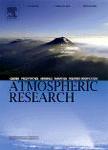版权所有:内蒙古大学图书馆 技术提供:维普资讯• 智图
内蒙古自治区呼和浩特市赛罕区大学西街235号 邮编: 010021

作者机构:Chinese Acad Sci Northwest Inst Ecoenvironm & Resources Key Lab Land Surface Proc & Climate Change Cold & 320 Donggang West Rd Lanzhou 730000 Gansu Peoples R China Univ Chinese Acad Sci Beijing 100049 Peoples R China Chinese Acad Sci Pingliang Land Surface Proc & Severe Weather Res Pingliang 744015 Gansu Peoples R China Nanjing Univ Inst Climate & Global Change Res Sch Atmospher Sci Nanjing Jiangsu Peoples R China Univ New South Wales ARC Ctr Excellence Climate Extremes Sydney NSW Australia Univ New South Wales Climate Change Res Ctr Sydney NSW Australia
出 版 物:《ATMOSPHERIC RESEARCH》 (大气研究)
年 卷 期:2019年第218卷
页 面:335-346页
核心收录:
学科分类:07[理学] 070601[理学-气象学] 0706[理学-大气科学]
基 金:National Basic Research Program of China (973 Program) [2014CB441404] National Natural Science Foundation of China [41575014, 41805003] CAS 'Light of West China
主 题:Storm identification Storm tracking Split-merge Algorithm evaluation
摘 要:Many storm identification and tracking algorithms based on radar data have been designed and widely used in weather forecasting. However, most of these algorithms have concentrated on storm cells. As a convective storm splits (merges), many storm cells will be generated (disappeared) within close proximity to each other resulting in errors in storm tracking and analysis of storm evolution. To resolve this, a new combined storm identification tracking algorithm (referred as CSIT) is devised after detailed testing of various existing convective storm identification and tracking methods. The connected neighborhoods labeling and a lower radar reflectivity threshold(30dBz) is used in CSIT, which ensures that newly formed storms can be detected. Moreover, with a lower reflectivity threshold, merger of convective cells is regarded as one convective storm, thus reducing the occurrence of storm split-merge. In terms of storm tracking, five tracking algorithms with different storm motion estimation, search radius calculation, and matching principles are designed and quantitatively evaluated using the contingency table approach and objective method. The best-performing algorithm that considers different situations of storm splitting and merging is selected to devise CSIT and the optimal thresholds for two parameters in the algorithm (i.e. maximum matching distance and search radius adjust factor) is determined through a series of sensitivity tests and objective evaluation using six years of warm season (JJA) radar data from 2012 to 2017. The devised storm identification and tracking algorithm has the potential to be applied to other data, such as cloud top brightness temperature from satellites, lightning frequency and other model output variables. The objective evaluation method does not rely on manual tracking results and thus can be used to improve and adapt automatic tracking algorithms for different situations (different storm types, regions etc).